This article appeared in the Volume 4, Issue 3 Winter 2024 issue of the Appalachian Curator. Click here to view a PDF of the full issue.
By Stewart Plein, Curator, Rare Books, Printed Resources, Appalachian Collection, West Virginia University
In my role as curator of rare books and the Appalachian book collection at WVU, I’m always on the lookout for books that add research value to our collections. One of my favorite go to resources is often referred to as Appalachian Local Color Literature, popular during the nineteenth and early twentieth century. I consider this time period to be of exceptional importance to Appalachian Studies as a documentation of a national perception of Appalachia and its people during this time. These books represent the birth of the Appalachian stereotype, and while stereotype is often considered to have arisen within the pages of these novels and non-fiction works, stereotype is also represented on the covers of books. These cover designs are the initial image a buyer sees, first to grab the prospective purchasers’ attention with design and detail in multiple colors, second, to provide the book’s setting, (if the rhododendron is on the cover it’s a sure bet the book is about Appalachia), and third, to provide context with a depiction of an event or image that sets the scene, whether it’s romance, moonshining, hunting, feuding, or any number of standard Appalachian tropes that can be depicted on the cover of a book in a single eye grabbing image.
In this article we’ll be looking at three editions of the same book: what they tell us about Appalachia and why the study of the same text in different editions or formats is important to the study of Appalachia. You would not be alone if right about now you’re asking yourself why? Why is it important to collect different copies of the same book? I hope I can answer that question.
The books:
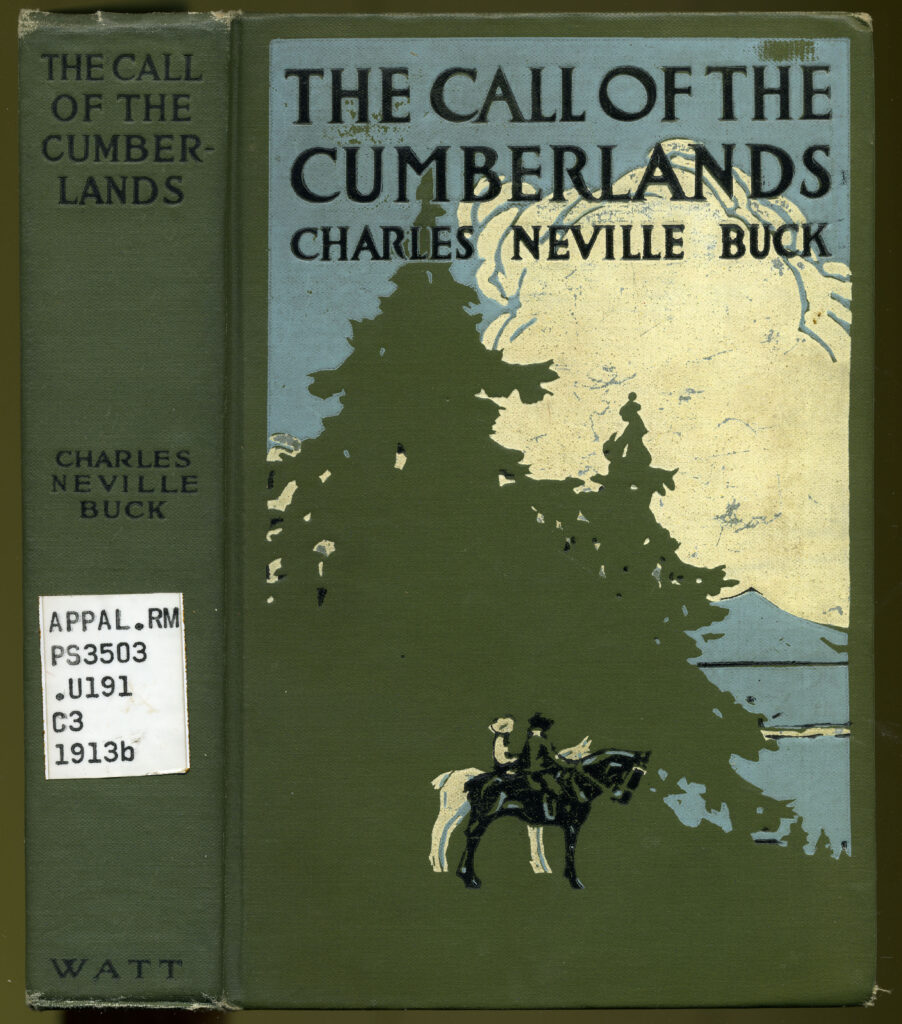
The First Edition:
This cover design depicts the immensity of the Appalachian wilderness. It serves as a reflection of the initial reactions of travelers, newly arriving in Appalachia from eastern urban centers, what we might call sight seers or tourists today. This cover design displays Appalachia as a large and uninhabited wilderness. Everything is outsized on the cover, the big sky with billowing clouds, the evergreens, and the mountains in the background. This perspective is enhanced by the miniaturization of the travelers on horseback. Their smallness within the natural surroundings helps to convey the idea that travelers were small in comparison and lost in such a vast wilderness. As America became more urban, rural places like Appalachia seemed static. Travelers from big cities looked at Appalachia and felt lost from many different perspectives. This included an appearance of lack in general; such as a shortage of schools, a lack of stores selling goods like clothing and food, a perceived lack of community norms, like courts or policing. This cover beautifully and simply depicts travelers lost in the immensity of the Appalachian wilderness.
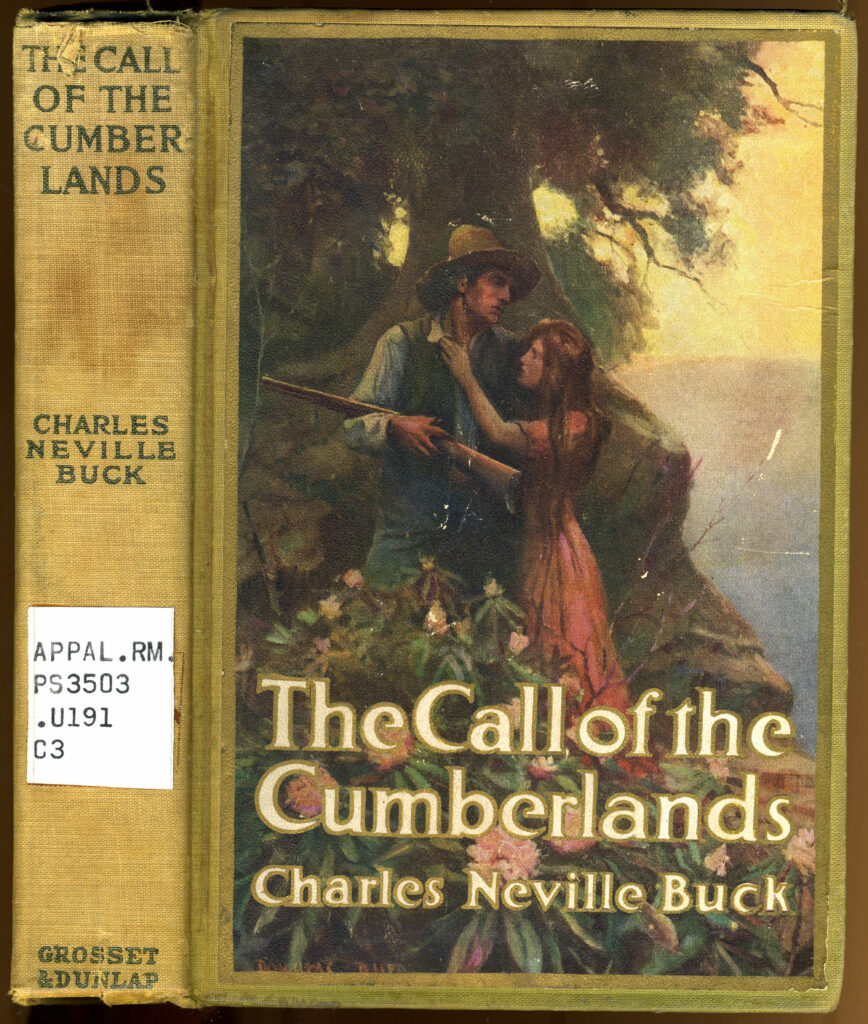
The Popular Reprint Edition:
The Call of the Cumberlands was so popular among the reading population that it made the very first bestseller lists. Because of its popularity, it was reprinted with a different cover depicting characters from the story. Here we see a lovelorn lass of the hills, clinging to a man who looks very uncertain about her attentions.
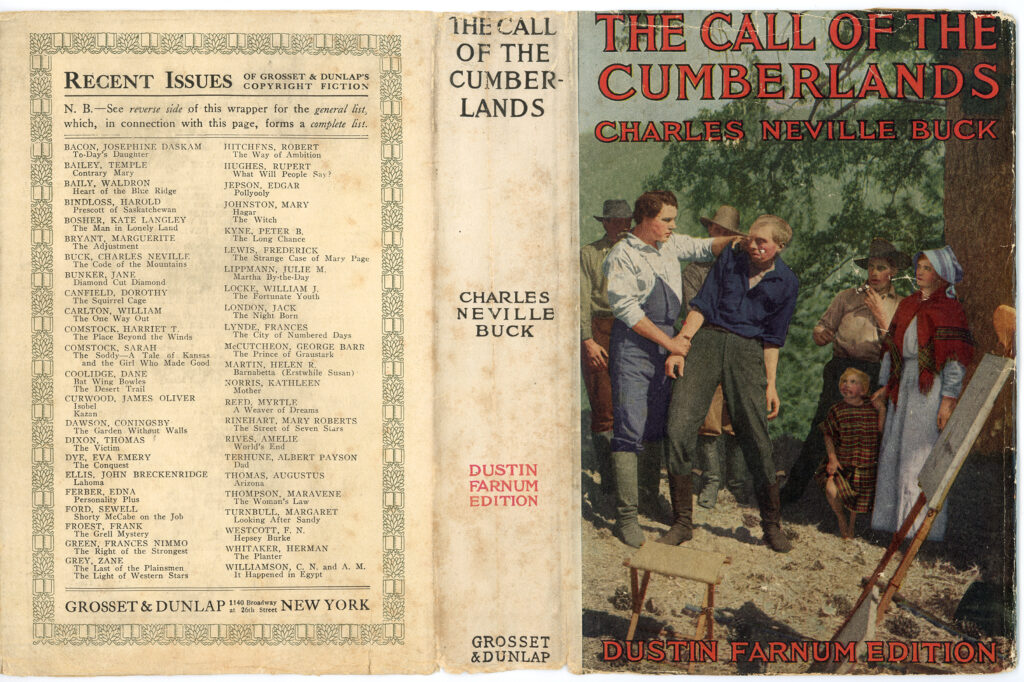
The Reprint Publisher: Grosset & Dunlap
Notably a reprint publisher, Grosset and Dunlap was also known to publish first editions, particularly in its early days. As a reprint publisher, Grosset & Dunlap purchased the plates from the original publisher, in this case, W. J. Watts. The book was printed in its entirety from the original plates and in a move that has since confused many book collectors, the title page lists the original publisher, not Grosset & Dunlap. Their name is only seen at the base of the book’s spine.
Grosset & Dunlap editions, once disregarded, have since become important because of the entire duplication of the original text, but also because they were the first to reprint a best seller or popular book in a cheaper edition within the first year of its publication. Grosset & Dunlap’s reprints were hard bound editions but today, they can be considered as the forerunner of a paperback following its run as a first edition. This practice documented the publishers’ effort to produce lesser editions in both quality and cost in the mid to later 20th century.
One thing to note is though the original publishers, Watts, owned the book cover design which was commissioned by them, the majority of the time that was not conveyed to the reprint publishers, leading the reprint house to select a new image. In the case of the Grosset & Dunlap edition, the frontispiece illustration, the first one you see when you open the book, has been reprinted and used as the cover of the reprint edition. An inexpensive and easy approach to cover art.
Photoplay edition:
What is a photoplay? It’s a term contemporary to the period of a popular novel that was made into a silent film. The book often contains stills from the silent film in which actors and scenes are included as the illustrations. Gone are the artists’ depictions of the earlier publications. In their place are stills from the film. Movie tie-ins are familiar to us today. Novels you may have already read have been turned into movies and reprinted with the actors on the book’s cover. This is the same thing, except scenes, or movie stills, from the film are also included as illustrations. For me, I find collecting photoplay editions to be of great importance. In most instances, the silent film has not survived. The photoplay edition is often the only evidence that remains of the silent film version of an Appalachian Local Color novel. Without this record we may never know that a film was produced from the novel, who starred in it, how costumes represented the dress of Appalachian people, how sets documented the Appalachia region, both from an outdoor perspective as well as an interior scene in the home, or the publicity and marketing of the film through movie posters.
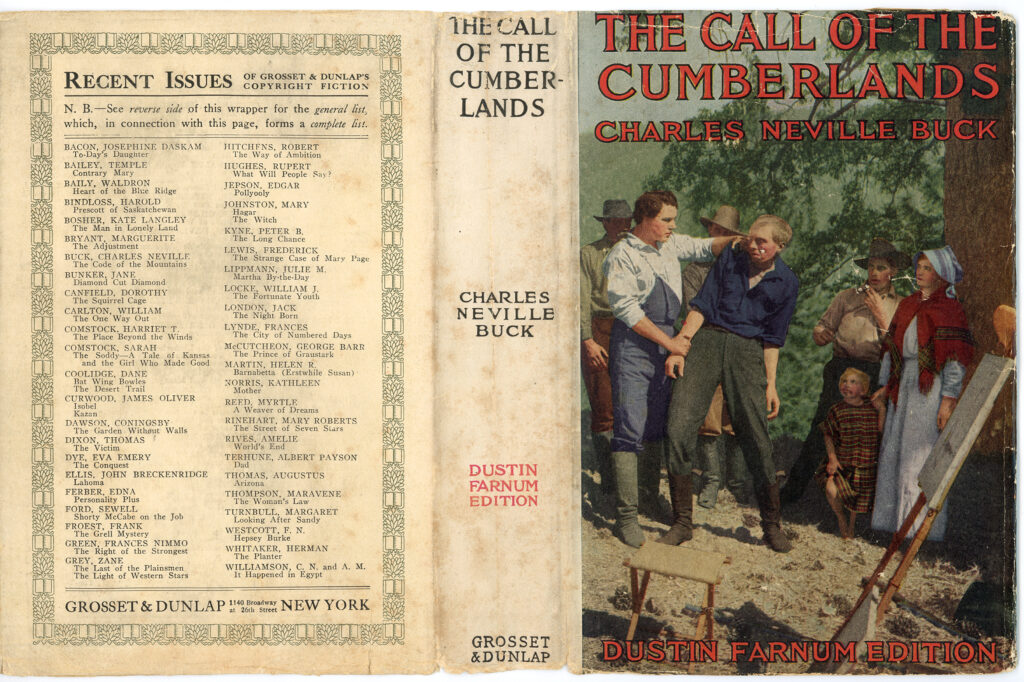
THE DUST JACKET for the photoplay edition:
Among these three editions, the dust jacket for the photoplay edition is the only survivor, but it tells us a great deal about the publicity and marketing of the silent film version of a popular novel. Many people throw dust jackets away, considering them a nuisance, but dust jackets are critically important to our knowledge of the book. Take this dust jacket for example. The cover bears a colorized scene from the film, which is of interest as all silent films were black and white. The back cover lists new books offered by the publisher.

Turn the jacket over and you have a full list of the books available from this publishing house. Many times, though not in this instance, prices were also included. This could be considered a mini catalog advertising new titles available to order.
Dust Jacket Flaps:
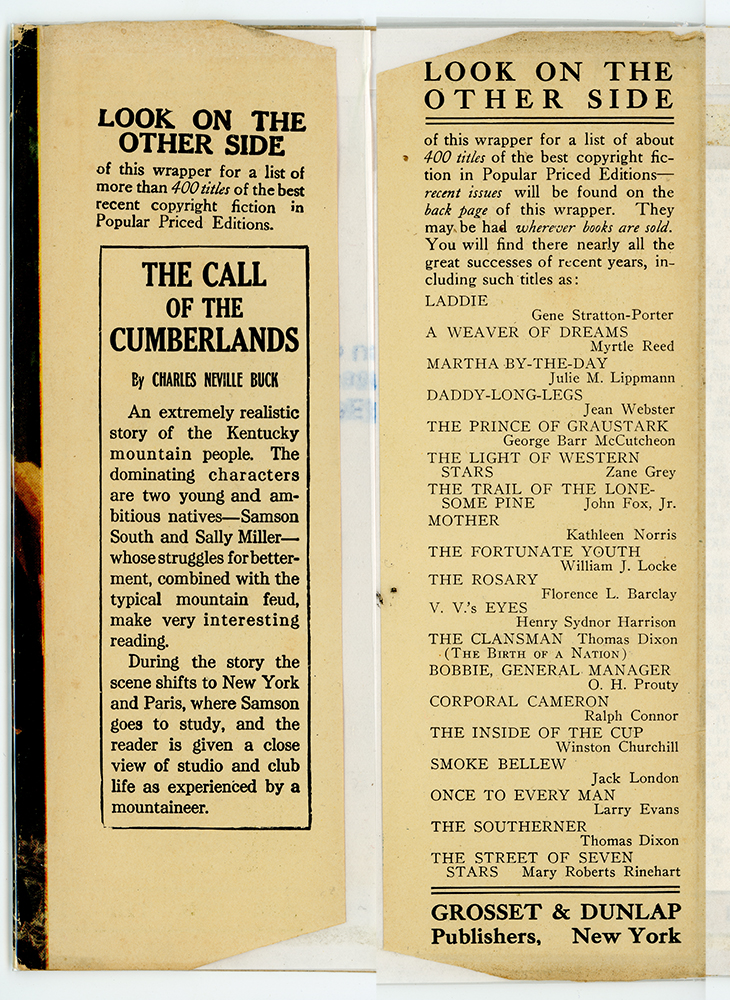
The first thing seen on the front flap is a “blurb,” a publicity statement about the book: “An extremely realistic story of the Kentucky mountain people . . . Whose struggles for betterment, combined with the typical mountain feud, make very interesting reading.” (Italics added by author)
The dust jacket flaps fold around the book to keep it secure. The jacket itself is designed to protect the book, but it also serves as a form of advertisement. The flaps are no different. Flaps are often printed with a description of the novel, as seen here, and provides a peak at other titles that might interest the reader.
No space on the dust jacket is wasted. Every space on the jacket was used. It functions as an informational guide to the book itself, as the publishers’ catalog, and as a marketing tool designed to inform customers and encourage purchasing in a Spotify sort of way – if you liked this book, you might like. . .
Inside the photoplay
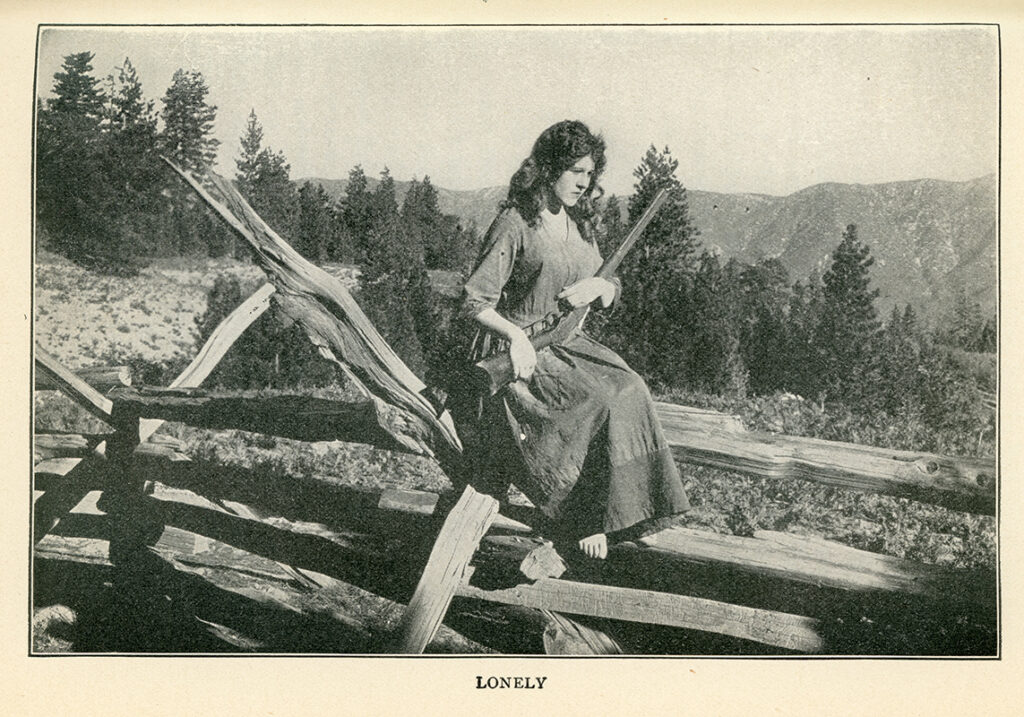
The still above features the lead actress, Winifred Kingston, as character Sally Spicer. Sally picks up a rifle to protect herself from unwanted male attentions after a rape attempt. Although the depiction is meant to make Sally look like she can take care of herself, the fact that she holds the rifle upside down depicts otherwise. The single word caption describes her as Lonely. She is shown barefoot in a Hollywood costume meant to represent homespun clothing appropriate for the time period. We would never know any of this without scenes from the film.
Tropes:
This list represents some of the common Appalachian tropes that appear in the book and the film, but are widespread in the genre of Appalachian Local Color Literature. This is where the stereotype of Appalachia began and it is still prevalent today.
- Feuding Families: Two violently feuding Appalachia families inspired by… the infamous Hatfield McCoy feud.
- Hillbilly dialect: Often used in the silent era, example: “Hit’s” for “Its.”
- Attempted Rape: She grabs a shotgun and fends him off.
- Politically Incorrect Hero: Main character justifies his decision to study art abroad while financée is left behind by saying that there’s no reason for women to go to school. (Italics added by author).
- Torches and Pitchforks: Feudists are chased with torches and bloodhounds.
- https://tvtropes.org/pmwiki/pmwiki.php/Film/TheCallOfTheCumberlands
Questions to consider?
Why is it important to collect different copies or editions of the same book?
How do these books aid in our understanding of Appalachia?
Why is the dust jacket important? Will you ever throw out a dust jacket again? I hope not!
Conclusion: The Importance of Multiple Editions
The answer to our question? We need all of them. Each book tells us something different, each book informs us, each book reflects a different perspective, even though they are the same work by the same author. By their individuality they reflect similar but unique concepts about the representation and the depiction of Appalachia and its people that came into prominence in the late nineteenth and early twentieth century, and remains as the basis of the stereotypes still prevalent today
Stewart Plein is a scholar of book history that pertains exclusively to publishers’ bookbindings. She examines publishers’ representations of Appalachia as depicted in books with decorative covers and jackets that were commissioned by the publisher as a marketing tool.